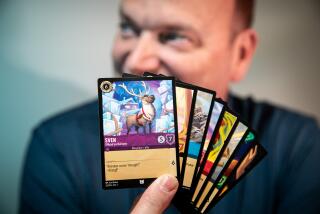Magic in the Air : Fantasy Trading Cards Are Casting a Spell on Game Players and Collectors Alike
- Share via
If you are still trying to figure out what a Pog is, forget it. It’s too late.
You’d be well-advised, instead, to focus your attention on Moxes, Obsianus Golem and the Thicket Basilisk.
No, those are not grievous typos.
They are some of the stars of Magic: The Gathering, a fantasy trading card game that has captured the attention of players and collectors of all ages, all over the world, since the release of its first edition in August, 1993.
Magic’s creator, Wizards of the Coast Inc., based in a Seattle suburb, has sold more than a half-billion cards since its inception, said Carrie Thearle, a company spokeswoman. A market research study by the company estimated there are 1 million players worldwide.
And if cards aren’t enough to satisfy the game’s fans, there are also four Magic-based novels published by HarperCollins and a CD-ROM on-line version of the game created by MicroProse Software, a division of Spectrum HoloByte Inc., of Maryland.
“From watching fads and phenomenons this is probably the biggest phenomenon I’ve ever seen,” said Joe Palladino, manager of Metro Comics in Santa Barbara. “It’s going to have a long life.”
That’s fitting, considering having a long life is what the game is all about.
Armed with a deck of cards, players are transformed into wizards battling to rule the mystical multiverse of Dominia. Spells and creatures are their artillery, aimed at zapping life points from their enemies.
Those who play the game say it’s not all that hard to learn, just virtually impossible to master.
About 350 cards have been issued, and only 40 cards are necessary for a game. That means players can build their own packs strategically.
All of the cards feature vivid color illustrations and some have been printed in limited edition. So Magic is also becoming a collector’s item. One card signed by the illustrator has been valued at $250.
“Magic just seemed to fill a niche,” said Steven Thesken, of the Gamesmanship game store in Costa Mesa. “Before Magic we had collectible cards and card games, and there were role-playing games (in which participants take on roles of characters). But this has combined all three.”
For the recreational player, a basic starter’s pack runs from $8 to $13. Booster packs, later editions used to enhance the basic packs, can go for $1.50 to $6 a pack. But if you’re really into conquering the universe, Thesken said it would cost about $1,500 to compile a super-competitive set.
But price hasn’t seemed to deter people from all demographic groups from giving Magic a try.
“Gamers love it. People who hadn’t been game players heard of it, tried it and loved it,” he said.
Indeed, about 220 players, ages 8 to upward of 70, turn out for weekly competitions at the Costa Mesa Women’s Club.
Clearly, Magic’s success is firmly established across the board. The question is, will the game go the way of Pogs before too long?
Diane Cardinale, a spokeswoman for the Toy Manufacturers of America, said it’s difficult to predict the longevity of pop culture fads.
“It’s whatever seems to capture the imagination at any given time,” she said. “Magic may be popular in five or 10 years, or it may just disappear.”
More to Read
The biggest entertainment stories
Get our big stories about Hollywood, film, television, music, arts, culture and more right in your inbox as soon as they publish.
You may occasionally receive promotional content from the Los Angeles Times.










